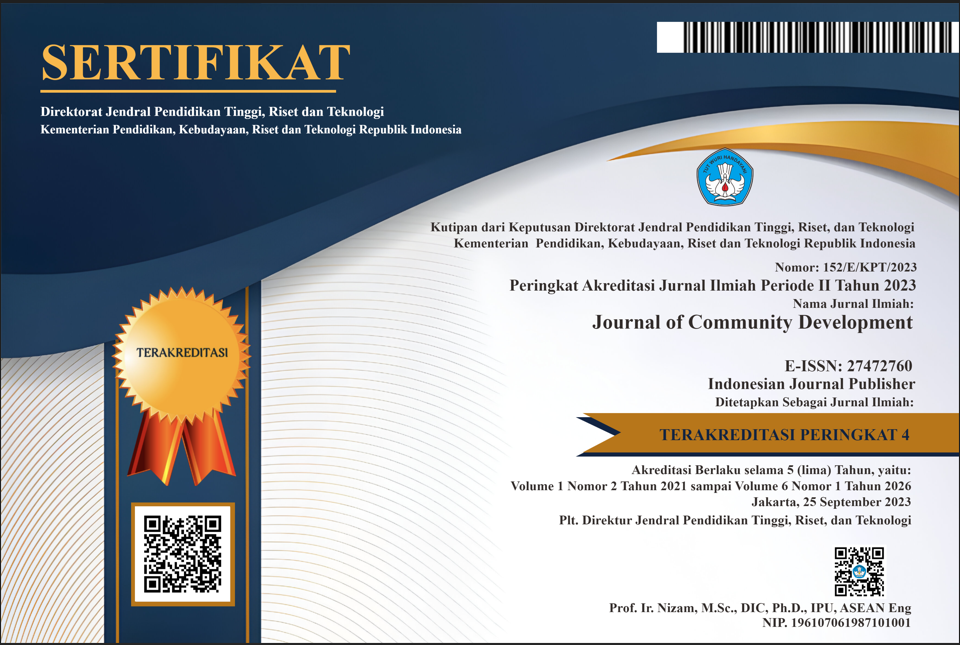Pengenalan Argot: Komunikasi Terselubung Komunitas Pengguna NAPZA
DOI:
https://doi.org/10.47134/comdev.v3i3.104Keywords:
argot, Community, NAPZAAbstract
This socialization is carried out in line with the development of increasingly sophisticated digital and communication technology, by showing how easy anything is done nowadays. One of which is the circulation of narcotics and illegal drugs whose circulation is concealed and is common among teenagers. The purpose of this provision is to increase insight, knowledge, public awareness, and effective communication, especially for teenagers regarding the dangers on the use of Narcotics, Psychotropics, and Addictive Substances (Drugs). The method of the provision is carried out through two stages (1) preparation, it is done by preparing selected materials as well as the presentation of the chosen materials by the team. (2) Having online socialization through zoom meeting from the team to the participants. This activity is also to celebrate the 20th Anniversary of BNN RI. The result of this provision activity is increasing public awareness, especially teenagers about the dangers of drugs. This can be seen from the discussion session, especially the use of argot in the drug community, which has become a valuable insight for participants.
Downloads
References
Beatty, S. E., Cross, D. S., & Shaw, T. M. (2008). The impact of a parent-directed intervention on parent—Child communication about tobacco and alcohol. Drug and Alcohol Review, 27(6), 591–601. https://doi.org/10.1080/09595230801935698
Cuijpers, P. (2003). Three Decades of Drug Prevention Research. Drugs: Education, Prevention and Policy, 10(1), 7–20. https://doi.org/10.1080/0968763021000018900
Huansuriya, T., Siegel, J. T., & Crano, W. D. (2014). Parent–Child Drug Communication: Pathway From Parents’ Ad Exposure to Youth’s Marijuana Use Intention. Journal of Health Communication, 19(2), 244–259. https://doi.org/10.1080/10810730.2013.811326
Karlander, D. (2021). Cities of sociolinguistics. Social Semiotics, 31(1), 177–193. https://doi.org/10.1080/10350330.2020.1810550
Mallick, J. (2003). Let’s Talk Drugs: The need for effective parent-child communication within drug education. International Journal of Adolescence and Youth, 11(1), 41–58. https://doi.org/10.1080/02673843.2003.9747916
Newcomb, M. D., Abbott, R. D., Catalano, R. F., Hawkins, J. D., Battin-Pearson, S., & Hill, K. (2002). Mediational and deviance theories of late high school failure: Process roles of structural strains, academic competence, and general versus specific problem behavior. Journal of Counseling Psychology, 49(2), 172–186. https://doi.org/10.1037/0022-0167.49.2.172
Nezami, E., Sussman, S., & Pentz, M. A. (2003). Motivation in Tobacco Use Cessation Research. Substance Use & Misuse, 38(1), 25–50. https://doi.org/10.1081/JA-120016564
Skara, S., & Sussman, S. (2003). A review of 25 long-term adolescent tobacco and other drug use prevention program evaluations. Preventive Medicine, 37(5), 451–474. https://doi.org/10.1016/S0091-7435(03)00166-X
Velleman, R. D. B., Templeton, L. J., & Copello, A. G. (2005). The role of the family in preventing and intervening with substance use and misuse: A comprehensive review of family interventions, with a focus on young people. Drug and Alcohol Review, 24(2), 93–109. https://doi.org/10.1080/09595230500167478
Wills, T. A., & Stoolmiller, M. (2002). The role of self-control in early escalation of substance use: A time-varying analysis. Journal of Consulting and Clinical Psychology, 70(4), 986–997. https://doi.org/10.1037/0022-006X.70.4.986
Downloads
Published
How to Cite
Issue
Section
License
Copyright (c) 2022 Astri Widyaruli Anggraeni, Kristi Nuraini, Adetya Pratika Aprilia, Andini Cahyaningrum

This work is licensed under a Creative Commons Attribution 4.0 International License.







